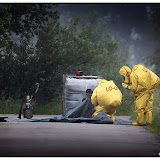ffemt19's Groups
ffemt19's Page
Profile Information
- Type of Organization
- Combination Fire Rescue Department
- Job Function
- Captain
- Years in Fire/EMS:
- 16
- Primary Fire/EMS Department:
- Lommel Fire Rescue
- Years With Department/Agency
- 17
- Dept. Web Site:
- http://www.brandweerlommel.be
- Web Site:
- http://www.civilsecurity.be/
- Other Past or Current Departments and Organizations
- Instructor @ local fire training facility
hospital EMS service (retired)
- My Training:
- - Interior firefighting
- Extrication (basic -> advanced)
- High Rise Rescue (rope rescue)
- USAR
- EMS
- HAZMAT
- Extrication
- Dispatching
- About Me:
- Member of Belgium First Aid and Support Team (International Aid)
- USAR team INSARAG Medium USAR Classefied
- High Capacity Pumping
- Forest Fire Fighting
- Day Job:
- Federal Civil Defence Department (USAR & HAZMAT + support Fire Rescue Department)
- Relationship Status:
- Married
- Why I Joined Fire/EMS
- 3th generation firefighter soo i think it is kind of in my blood.
Like too be there for my comunity
ffemt19's Videos
-
Civil Security Belgium
Added by ffemt19 0 Comments 0 Likes
Ffemt19's Blog
Ranks in Belgian fire service
Posted on February 7, 2009 at 12:59pm 1 Comment 1 Like
European Helmets and SCBA
Posted on February 5, 2009 at 11:40am 5 Comments 0 Likes
MSA
Draeger
Most of our helmets have build in neck curtains for neck protection but we all use hoods under the helmet with neck curtain.
Lommel Fire Department
Posted on February 4, 2009 at 3:30pm 0 Comments 0 Likes
Serving approx. 82000 people
2 Stations (1 in Lommel = HQ & 1 in Neerpelt)
We have 28 proff. firefighters (for the 2 stations)
Station Lommel:
50 paid on call firefighters
3 engines
2 rescue
1 truck/ladder
3 brush trucks
2 water tenders
2 container carriers
1 HAZMAT container
1 stabilazation container (cribbing/shoring)
1 hose layer container
2 chief cars
6 cars
2 ALS ambulances
Station…
Specialty Websites
Find Members Fast
Firefighting Videos
© 2025 Created by Firefighter Nation WebChief.
Powered by
![]()
Badges | Contact Firefighter Nation | Privacy Policy | Terms of Service





Comment Wall (30 comments)
You need to be a member of My Firefighter Nation to add comments!
Join My Firefighter Nation
Good day! I am a collector from Ukraine. I suggest you to exchange patches.
Andrew. tkachenko_van@optima.com.ua
In the US, we do that precisely for that reason, and we call them flashover simulators. It takes training of course, but a firm grasp of the thermal dynamics involved in these sea container style trainers helps considerably. In the US, we use several types: the original swede flashover simulator, the all important Phase 5 simulator, and some other divergent models and layouts. Backdrafts occur in these when innstructors are understaffed or undertrained. Please search that on Google and check out some write ups and images.
Pencilling the ceiling with a straight stream from a fog nozzle to keep the gases below flashpoint takes skill and TICs or thermal imaging cameras help to keep the crew safe by seeing the rollover through the smoke. Several instructors must keep their eyes on the task at hand. Rehab and RIT/FAST teams must be also on standby, ready to go at a moments notice. Back up hoselines and emergency exit door hatches can always be installed in the roof or in the sides of the container if the fire gets a little over zealous.
The way you get the body of fire is by there being chains installed on the walls and ceiling at one far end of the container. Behind these chains plywood can be slid in to simulate how the contents of a dwelling will burn.
In the US I would have to say that most FDs are likely to steer clear of burning wet hay. Steam is not friendly or conducive to the type of training you guys appear to be doing. Restrict the air flow of a burning barrel of wood once it is hot. It will smoke. Is there any reason why you couldnt use supplementary artificial smoke? Simple combustion should not be messed with in live burns, at least in my opinion.
I'm trying to get in contact with someone from Belgium and found you here.
I am collecting some educational material from different stations and countries to put them all in one place on the web, like a knowledge bank to use when creating exercises for your own station, something to draw ideas from.
Do you think it would be possible for me to get a hold of a powerpoint in tactical ventilation/PPV ventilation or what you might call it from you?
It will be added to a website translated into English, later you can find several other documents from other stations in return that you can use.
Best regards / Lars
wampa
View All Comments